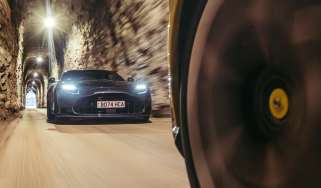The best investment cars: 2010-2015
Classics have seen their values skyrocket in recent years
Evidence from the past five years suggests that the classic car industry has fully recovered from the effects of the 2008 global financial crisis. In fact, recent auction sale prices indicate that not only has it recovered, but also that it has already surpassed any previous levels.
Classic car values are now accelerating at an unprecedented rate, with auction records broken year after year – so much so that RM Sotheby is confidently predicting that it’s Monterey Auction in August will surpass £100million in sales, beating 2014’s record-breaking £93.4million event.
But what are the main culprits in this rapid increase in prices? And are there more – and we use the term loosely – affordable cars that have been touched by the appreciation stick? Below, aided by a copy of Octane magazine’s Classic Car Price Guide and with helpful advice from Classic and Performance Car, we identify five classic cars (and more in our gallery) that have made far greater financial returns than leaving money in a bank account. Look away now if you sold one of the following in 2010…
Ferrari 288 GTO, 1984-1987
The Ferrari 288 GTO could so easily have been a failure. Though it wore the racing-oriented GTO badge, it’s exterior was clearly based on the ageing 308 GTB. Thankfully, the GTO proved fast in both road and race spec, utilising power from a compact 2.9-litre V8 engine that produced 400bhp and enabled a 190mph top speed. It quickly became the must-have Ferrari for collectors.
Combine this performance with a low build number – just 272 were ever assembled – and it’s unsurprising to hear that the 288 GTO was valued at £400,000 in 2010. However, such is the demand for classic Ferrari supercars, and in particular models of the 1980s, that 288 GTOs are now valued at £2million. That’s a 400 per cent increase in five years.
Ferrari F40, 1987-1992
From one 1980s Ferrari to another, perhaps the less rare F40 will provide a more accurate representation of what the classic car market is doing. In total, 1315 F40s were built, all of which received power from Ferrari’s 471bhp twin-turbocharged 2.9-litre V8.
Thanks to its miserly 1100kg kerb weight, the F40 produces a healthy 437bhp/ton. However, it was the way in which the car’s heavily turbocharged engine produced its power – it essentially arrives in one lump at 4000rpm – that ensured it was quickly labelled as one of the most savage supercars ever built.
Five years ago F40s in average condition could be picked up for around £170,000; well looked after examples were valued at £300,000. Today, you’ll need £600,000 just to be in with a shout of buying one, and for an excellent F40 you could be looking at spending £900,000 to £1million… What is it with 1980s Ferraris with pop-up headlights?
McLaren F1, 1993-1998
Even more than two decades on from its launch, many still label the McLaren F1 as the ultimate supercar. When it arrived in 1993 the three-seater blew the competition (namely Ferrari and its F40) out of the water. Razor-sharp throttle response from its 627bhp BMW-built 6-litre V12 and a featherweight carbon chassis enabled the F1 to accelerate from 0-62mph in just 3.2sec before powering on all the way to 240mph.
Unsurprisingly, all 106 examples of the F1 ever built are incredibly valuable. But the F1 is neither a Ferrari nor a pop-up-headlight-wearing supercar, so it might not have followed the lead of the two aforementioned cars…
Five years ago, £2.5million was about the going rate for a well looked after McLaren F1. Today you’ll need to add more than £5million to that number. Proof of that comes from the recent sale of Rowan Atkinson’s twice-rebuilt F1: it went for an estimated [sharp intake of breath] £8million. Eight million.
Aston Martin DB4 Zagato, 1958-1963
The Aston Martin DB4 Zagato wore lightweight aluminium bodywork and sat on a shorter, DB4 GT-based wheelbase. Originally Aston Martin intended to produce 25 examples of the 1225kg sports car, but a lack of demand saw that reduced to 20.
Under the bonnet was a more powerful version of the DB4’s 3.7-litre straight-six, producing 314bhp and capable of powering the car all the way to 154mph. This achingly beautiful Aston is both fast and incredibly rare, then.
For that reason, offering a Zagato owner £6million might tempt them into a sale, but realistically you’d have to add £2million to that offer to have a serious chance. Just three years ago, even Phil Collins’s own DB4 Zagato could only sell for a seventh of that (c£1.2million).
BMW E30 M3, 1986-1990
In an attempt to return to the ‘real world’, let’s consider a car that, in this company at least, is much more affordable. The E30 BMW M3 was born out of Group A touring car homologation requirements, utilising power from a 2.5-litre four-cylinder engine that produced 192bhp at launch (power eventually grew to 238bhp).
The car was so good that it was borderline groundbreaking, mixing sports car performance with everyday practicality. As such, it sold in vast numbers – 17,184 were made – meaning many survive today.
Thanks to a cult-like following, the E30 M3 was valued at £27,500 back in 2010, with average examples still selling for around £11,000. Fast-forward to the present and values have, of course, rapidly increased. Average E30 M3s sell for more than £20,000, but excellent cars require a significant £45,000.
As the five cars above show, prices at both ends of the market are soaring. To see more cars that have seen their values rapidly increase, have a look through our gallery. You can find 1000s of investment-worthy cars on Classic and Performance Car.


